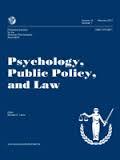
Criminals with a genetically predisposed psychopathology are seen as more blameworthy than those having psychopathology with an environmental etiology. This is the bottom line of a recently published article in Psychology, Public Policy, and Law. Below is a summary of the research and findings as well as a translation of this research into practice.

Featured Article | Psychology, Public Policy and Law | 2017, Advanced Online Publication
Crime, Punishment, and Causation: The Effect of Etiological Information on the Perception of Moral Agency
Author
Philip Robbins, University of Missouri
Paul Litton, University of Missouri
Abstract
Moral judgments about a situation are profoundly shaped by the perception of individuals in that situation as either moral agents or moral patients. Specifically, the more we see someone as a moral agent, the less we see them as a moral patient, and vice versa. As a result, casting the perpetrator of a transgression as a victim tends to have the effect of making them seem less blameworthy. Based on this theoretical framework, we predicted that criminal offenders with a mental disorder that predisposes them to antisocial behavior would be judged more negatively when the disorder is described as having a genetic origin than when it is described as environmentally caused, as in the case of childhood abuse or accident. Further, we predicted that some environmental explanations would mitigate attributions of blame more than others, namely, that offenders whose disorder was caused by childhood abuse (intentional harm) would be seen as less blameworthy than offenders whose disorder is caused by an unfortunate accident (unintentional harm). Results from two vignette-based studies designed to test these predictions, conducted with participants recruited from Amazon Mechanical Turk (N=244 and N=387, respectively), confirmed the first prediction but not the second. Implications of this research for three areas—the psychology of moral judgment, philosophical debates about moral responsibility and determinism, and the practice of the law—are discussed in the sequel.
Keywords
moral typecasting, blame, punishment, responsibility, causation
Summary of the Research
“Are physiological or environmental explanations relevant to determining […] culpability [in] crimes? Aside from this puzzling philosophical question, it is important to know whether people generally find such explanations relevant to blame and punishment. Accordingly, empirical researchers have investigated the extent to which such causal explanations influence ordinary intuitions about appropriate punishment. With scientific knowledge advancing with respect to the causes of antisocial conduct, it should be helpful to lawyers and lawmakers to know the extent to which such evidence may affect judges and juries. Empirical research into the effect of causal explanations on judgments of blameworthiness, moral responsibility, and appropriate punishment could have practical importance for criminal lawyers as well as for courts assessing the obligations of counsel.” (p. 1)
“A natural starting point for this investigation is empirical research on the general structure of moral cognition. Of particular relevance to our project is the Theory of Dyadic Morality (TDM), which posits a single cognitive template underlying all moral judgments. According to TDM, moral judgments about a situation are profoundly shaped by the perception of individuals in that situation as either moral agents or moral patients. By definition, a moral agent has the capacity to perform morally good or bad actions, whereas a moral patient has the capacity to be on the receiving end of such actions. The conceptual dichotomy between agency and patiency is governed by the principle of “moral typecasting”: The more we see someone as a moral agent, the less we see them as a moral patient, and vice versa. In other words, moral agency and moral patiency are antithetical roles, and moral actors tend to be cast in one role to the exclusion of the other, even across contexts. For example, casting the perpetrator of a transgression as a victim of harm tends to have the effect of making them seem less blameworthy.” (p. 2)
“In the present context, the significance of TDM as an account of moral cognition is largely because of the fact that it generates clear predictions about how etiological information will influence the way people think about criminal behavior. According to the theory, we should expect that criminal offenders with a mental dis- order that predisposes them to violent antisocial behavior will be judged more negatively when the disorder is described as having a genetic origin than when it is described as environmentally caused, as in the case of childhood abuse or accident. The basis of this prediction is as follows. When the disorder has an environmental origin, there is a preexisting person who has suffered harm; hence, the perception of their moral patiency should be heightened, and the perception of their moral agency attenuated, by the addition of etiological information. When the disorder has a genetic origin, by contrast, there is no preexisting person to whom harm has been done (because no person exists before the determination of their genetic profile), so the perception of their moral agency should be unaffected by the receipt of information about the cause of their pathology. In other words, offenders whose disorder arises from environmental causes should be seen as less blameworthy than offenders whose disorder is caused by bad genes, because the former will be seen as victims but the latter will not. Moreover, genetic explanations of psychopathology, insofar as they do not implicate personal harm or victimhood, should not affect the perception of moral agency.” (p. 2)
“Results from the two studies presented here show that ordinary judgments of blame, punishment, and other aspects of moral agency are sensitive to information about the etiology of psychological impairments in criminal offenders. In line with the Theory of Dyadic Morality, offenders whose psychopathology was because of environmental causes were seen as less deserving of moral sanction than those whose pathology was genetic in origin; indeed, offenders whose pathology was genetic were judged no less negatively than offenders whose pathology was given no etiological explanation at all. These findings are consistent with prior studies finding no mitigation effect for genetic causal stories on judgments of blame and punishment. However, our results contrast with some previous research on whether evidence of suffering childhood abuse mitigates judgments of blame and punishment. We predicted that evidence of childhood abuse would produce greater mitigation in our studies because our vignettes, unlike those used in earlier research, included details about the abuse suffered. This prediction was borne out by our results.” (p. 7)
Translating Research into Practice
“The principle of moral typecasting says that the more we see someone as a moral patient (e.g., a victim), the less we see them as a moral agent (e.g., a villain), and conversely. Applied to the legal context, the principle suggests that criminal offenders will be judged less negatively when they are perceived as victims of harm relative to offenders who are not so perceived. Accordingly, it predicts that an agent whose criminal behavior is linked to psychopathology will be judged more negatively when the pathology is genetic rather than environmental in origin, because only in the environmental case will the agent be perceived as a victim of harm. This prediction was borne out by the results of Study 1. In two hypothetical crime scenarios, an offender with a brain disorder was perceived as more deserving of blame and punishment when the etiology of his disorder was genetic rather than environmental.” (p. 5)
“[O]ur findings are relevant to the practice of law, particularly in capital cases. It is important not to exaggerate the practical significance of the results reported here, however, especially given the fact that our participants were recruited from MTurk, and MTurk workers as a group are not perfectly representative of the communities from which jurors are drawn. That said, our research does suggest […] one way to escape blame is to be a victim, evidence of environmental etiology may be effective for the defense when the etiology of the disorder underlying the defendant’s wrongdoing implicates victimhood. Evidence of genetic etiology is a different story. Because genetic behavioral evidence is unlikely to reduce judgments of blame and responsibility, time and resources should be directed toward other strategies, especially if genetic behavioral evidence suggests future dangerousness.” (p. 9)
Other Interesting Tidbits for Researchers and Clinicians
Our findings in Study 2 about the effect of specifying a neural mechanism for an offender’s disorder also suggest further avenues for research. Attributing a neural basis to the disorder had only a small mitigating effect on judgments of moral responsibility and no effect on judgments of blame or punishment. This result contrasts to some extent with work by Greene and Cahill (2012), who found that psychiatric diagnostic evidence coupled with evidence from neuro- psychological tests and neuroimaging produced greater mitigating effects with respect to punishment than psychiatric diagnostic evidence alone, at least in cases in which the defendant presented a high risk for future dangerousness. Against this background, further investigation into the effect of neuroscientific evidence on judgments of blame and punishment is warranted. A natural extension of our project, for example, would be to add to the design of Study 2 an additional level of the mechanistic factor that included neuroimaging evidence.
Join the Discussion
As always, please join the discussion below if you have thoughts or comments to add! To read the full article, click here.






















